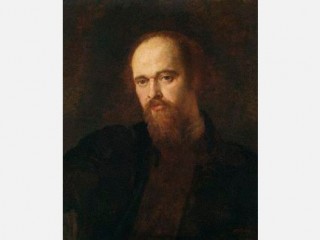
Dante Gabriel Rossetti biography
Date of birth : 1828-05-12
Date of death : 1882-04-09
Birthplace : London, England
Nationality : English
Category : Famous Figures
Last modified : 2011-02-17
Credited as : Poet and painter, Victorian art, cofounder of the Pre-Raphaelite Brotherhood
The English painter and poet Dante Gabriel Rossetti was a cofounder of the Pre-Raphaelite Brotherhood. His works show an impassioned, mystic imagination in strong contrast to the banal sentimentality of contemporary Victorian art.
Born on May 12, 1828, of Anglo-Italian parentage, Dante Gabriel Rossetti was steeped throughout childhood in the atmosphere of medieval Italy, which became a major source of his subject matter and artistic inspiration. After 2 years in the Royal Academy schools he worked briefly under Ford Madox Brown in 1848.
Shortly after Rossetti joined William Holman Hunt's studio later that year, the Pre-Raphaelite Brotherhood was formed, in Hunt's words, "to do battle against the frivolous art of the day." An association of artists so varied in artistic style, technique, and expressive spirit as the Pre-Raphaelites could not long survive, and it was principally owing to Rossetti's forceful, almost hypnotic personality that the Brotherhood held together long enough to achieve the critical and popular recognition necessary for the success of its crusade.
Rossetti did not have the natural technical proficiency that is evident in the minute detail and brilliant color of a typical Pre-Raphaelite painting, and his early oil paintings, the Girlhood of Mary Virgin (1849) and the Ecce Ancilla Domini (1850), were produced only at the expense of great technical effort. In the less demanding medium of watercolor, however, Rossetti clearly revealed his intense, compressed imaginative power. The series of small watercolors of the 1850s culminates in such masterpieces as Dante's Dream (1856) and the Wedding of St. George and the Princess Sabra (1857), characteristic products of Rossetti's inflamed sensibility, with typically irrational perspective and lighting, glowing color, and forceful figures.
In almost all his paintings of the 1850s Rossetti used Elizabeth Siddal as his model. Discovered in a hatshop in 1850, she was adopted by the Brotherhood as their ideal of feminine beauty. In 1852 she became exclusively Rossetti's model, and in 1860 his wife. Beset by growing melancholy, she committed suicide 2 years later. Rossetti buried a manuscript of his poems in her coffin, a characteristically dramatic gesture which he later regretted. Beata Beatrix (1863), a posthumous portrait of Elizabeth Siddal, the Beatrice to his Dante, is one of Rossetti's most deeply felt paintings: it is his last masterpiece and the first in a series of symbolical female portraits, which declined gradually in quality as his interest in painting decreased.
Although early in his career poetry was for Rossetti simply a relaxation from painting, later on writing gradually became more important to him, and in 1871 he wrote to Ford Madox Brown, "I wish one could live by writing poetry. I think I'd see painting d——d if I could… ." In 1861 he published his translations from Dante and other early Italian poets, reflecting the medieval preoccupations of his finest paintings. In 1869 the manuscript of his early poems was recovered from his wife's coffin and published the next year.
Rossetti's early poems under strong Pre-Raphaelite influence, such as "The Blessed Damozel" (1850; subsequently revised) and "The Portrait," have a sensitive innocence and a strong mystical passion paralleled by his paintings of the 1850s. As his interest in painting declined, Rossetti's poetic craftsmanship improved, until in his latest works, such as "Rose Mary" and "The White Ship" (both included in Ballads and Sonnets, 1881), his use of richly colored word textures achieves a sumptuous grandeur of expression and sentiment.
At his death on April 9, 1882, Rossetti had reached a position of artistic prominence, and his spirit was a significant influence on the cultural developments of the late 19th century. Although his technique was not always the equal of his powerful feeling, his imaginative genius earned him a place in the ranks of English visionary artists.
















